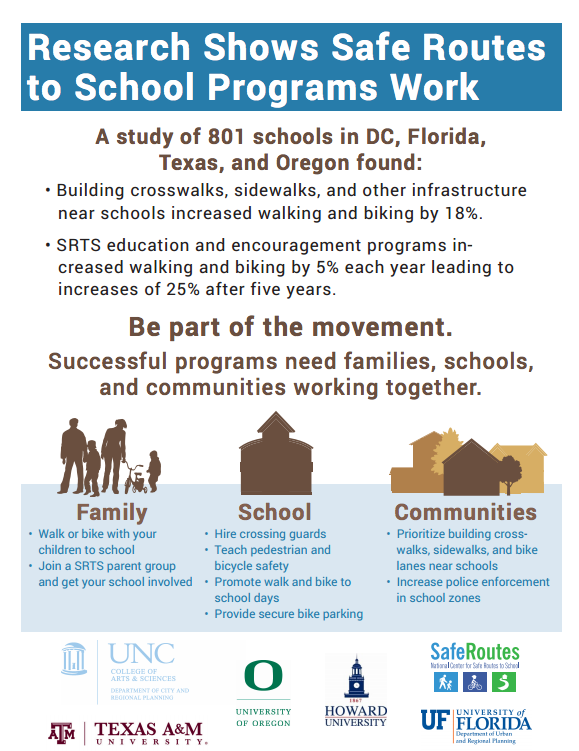 Just in time for International Walk to School Day, a new study has been published in the Journal of the American Planning Association that confirms what those of us in the field have long known: Safe Routes to School programs are effective at increasing rates of walking and bicycling to and from school.
Just in time for International Walk to School Day, a new study has been published in the Journal of the American Planning Association that confirms what those of us in the field have long known: Safe Routes to School programs are effective at increasing rates of walking and bicycling to and from school.
The new study is the most comprehensive Safe Routes to School evaluation to date – it looked at school travel data from 801 schools in DC, Florida, Oregon and Texas collected between 2007 and 2012. A total of 378 schools implemented Safe Routes to School programs of some kind during the study period—meaning that the researchers could look at before and after data—and 423 schools did not implement a Safe Routes to School program and could thus serve as control schools to compare against.
The findings are quite impressive:
- After an engineering improvement was completed, schools saw an 18 percent increase in walking and bicycling rates.
- Each year of Safe Routes to School education and encouragement programming resulted in a five percent increase in walking and bicycling rates—adding up to 25 percent after five years.
- These results could be cumulative – so a school that implements a comprehensive Safe Routes to School initiative with engineering improvements plus five years of education and encouragement would result in a 43 percent increase in walking and bicycling rates.
 This study builds on the work of many other researchers who have looked at individual models or results on a smaller group of studies, and it really is the missing link in clearly demonstrating the effectiveness of Safe Routes to School. There are a number of ways in which this study provides definitive findings that are helpful to practitioners:
This study builds on the work of many other researchers who have looked at individual models or results on a smaller group of studies, and it really is the missing link in clearly demonstrating the effectiveness of Safe Routes to School. There are a number of ways in which this study provides definitive findings that are helpful to practitioners:
- Because it covers such a large number of schools in multiple states, it shows that Safe Routes to School programs generally are effective, regardless of specific variations in how the programs are set up.
- It includes control schools—allowing the researchers to show that the increases in walking and bicycling were a result of the Safe Routes to School initiatives, regardless of environmental or demographic differences among schools.
- Because the researchers looked at both engineering improvements and programming over time, they were able to show that comprehensive Safe Routes to School programs that are sustained over time have an ever-increasing impact on rates of walking and bicycling to and from school.
- Due to the number of schools, the researchers were able to examine variables such as the income level and ethnic or racial makeup of participating schools, and found no difference in the results – showing that Safe Routes to School can be equally effective for a wide variety of schools and families.
When combined with a study from last year showing that Safe Routes to School initiatives reduced pedestrian injury by 44 percent, we can now definitely say that Safe Routes to School is improving safety for children, and getting more children walking and bicycling to and from school.
And, that is great news to cap off another successful Walk to School month! Please also join me in giving a big thank you to the researchers at the University of North Carolina at Chapel Hill, University of Florida, Texas A&M, Howard University and University of Oregon that collaborated together to complete this impressive study.

